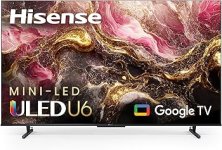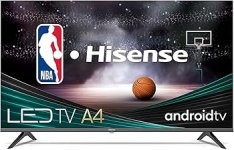EchoJoelle
New member
Catalogs Hide
- 1 Specs
- 2 Which to get
Today, we’re diving into a head-to-head comparison between two distinct offerings from Hisense: the U6 Series TV and the A4 Series TV. At first glance, these models seem to cater to different audiences, but let’s unpack their features and see if they truly deliver what they promise.
On one side, we have the Hisense U6 Series TV, boasting 4K ULED technology, which promises a vibrant picture with its advanced color and contrast capabilities. With the addition of MINI-LED and full-array local dimming, this model aims for that high-end viewing experience, making it an attractive option for cinephiles and gamers alike. The QLED quantum dot technology further enhances its color reproduction, claiming to bring images to life with over a billion color combinations.
On the other hand, there’s the Hisense A4 Series TV, which positions itself as a budget-friendly option with a 720p resolution. While it may lack the sharpness and color depth of the U6, it still offers a decent full-array LED backlight and Motion Rate 120 to keep up with fast-paced action. Plus, the dedicated Game Mode promises a more responsive gaming experience, which could appeal to casual gamers looking for value over cutting-edge specs.
So, which one is worth your investment? Is the premium price of the U6 justified by its advanced technology, or does the A4 Series hold its own as a practical choice for everyday viewing? Let’s break it down and see where your money is best spent.
I’m in the market for a new TV and I've narrowed it down to two Hisense models, but I need your input on which one to go for.
First up is the Hisense U6 Series TV. This one boasts 4K ULED technology, which promises a killer picture with boosted color, contrast, and brightness. Plus, the MINI-LED and FULL ARRAY LOCAL DIMMING should give me a more uniform image. I’ve heard the QLED QUANTUM DOT feature produces some absolutely stunning colors—over a billion combinations, they say! But, I’m curious if anyone has noticed any downsides with this model, especially regarding sound quality and overall system performance.
Then there’s the Hisense A4 Series TV. It's got a 720p resolution, which isn't as high-def as the U6, but it does have a full array LED backlight for sharper images. The Motion Rate 120 sounds great for sports and gaming—no lag, which is a plus for me. And the Game Mode is a nice touch for gamers. The downside here seems to be the lower resolution, but how does the picture quality stack up in real life? And what about sound quality on this one?
Which one would you recommend based on picture and sound quality, system performance, and any potential downsides? Thanks for your help!
On one side, we have the Hisense U6 Series TV, boasting 4K ULED technology, which promises a vibrant picture with its advanced color and contrast capabilities. With the addition of MINI-LED and full-array local dimming, this model aims for that high-end viewing experience, making it an attractive option for cinephiles and gamers alike. The QLED quantum dot technology further enhances its color reproduction, claiming to bring images to life with over a billion color combinations.
On the other hand, there’s the Hisense A4 Series TV, which positions itself as a budget-friendly option with a 720p resolution. While it may lack the sharpness and color depth of the U6, it still offers a decent full-array LED backlight and Motion Rate 120 to keep up with fast-paced action. Plus, the dedicated Game Mode promises a more responsive gaming experience, which could appeal to casual gamers looking for value over cutting-edge specs.
So, which one is worth your investment? Is the premium price of the U6 justified by its advanced technology, or does the A4 Series hold its own as a practical choice for everyday viewing? Let’s break it down and see where your money is best spent.
Specs
| Parameter | Hisense U6 Series TV | Hisense A4 Series TV |
|---|---|---|
Picture | ||
Screen Size | 75 Inches | 32 Inches |
Reference Price | - | $147.99 |
Model Year | 2023 | 2022 |
Specific Uses | Home Viewing | - |
Highlight | 4K ULED: Hisense’s proprietary ULED technologies boost color, contrast, brightness, and motion. This suite of patented hardware and software technologies delivers an engaging and completely unique picture that can only be delivered by Hisense MINI-LED & FULL ARRAY LOCAL DIMMING: Mini-LED is the latest breakthrough in backlighting technology. By utilizing LED’s that are significantly smaller than traditional LED’s we are able to use many more LED’s to create a bright image that distributes the light more evenly for a uniform image across the screen QLED QUANTUM DOT WIDE COLOR GAMUT: Quantum Dot QLED produces purer, richer, more brilliant and accurate color than a regular LED TV. Creating over a billion color combinations that bring vibrant images to life in a way non QLED TVs can’t | 720p Resolution: Along with its 720p high-definition LCD screen, you'll find a powerful full array LED backlight at work creating a sharper, more colorful picture. Motion Rate 120: Don't struggle to keep your eye on the ball—enjoy fast-paced sports, movies and gaming without the lag. Featuring Motion Rate image processing technology, this television keeps the thrills coming by making it easy to follow fast-moving action. Game Mode: Enjoy a better gaming experience. In Game Mode, input lag is significantly improved, so your commands from the controller are virtually instantaneous on the screen. |
Operating System | Google TV | Android |
Internet Applications | Prime Video, Google TV, YouTube, Browser | Netflix, YouTube, Hulu |
Controller Type | Remote Control, Voice Control | Voice Control |
Control Method | Voice | Voice |
Aspect Ratio | 16:9 | 16:9 |
Display Technology | QLED | LCD |
Screen Finish | Flat | Flat |
Has Color Screen | Yes | - |
Resolution | 4K | 720p |
Refresh Rate | 60 Hz | 60 Hz |
Response Time | 8 Milliseconds | - |
HDR Format | HLG, HDR10, HDR10+, Dolby Vision | - |
Maximum Brightness | 600 Nit | - |
Backlight Technology | Mini-LED | - |
Backlight Setting | Full Array Local Dimming | direct |
Picture Enhancement | High-end | HDR Compatible |
Motion Enhancement | 240 Motion Rate | Motion Rate 120 |
Audio Channels | 2.0 | 2.1 |
Audio Output | Surround | - |
Audio Input | HDMI | HDMI |
Speaker Description | 20W with Dolby Atmos and DTS Virtual:X | Virtual Surround Sound |
Surround Sound | Dolby Atmos, Imax Enhanced | DTS Virtual X |
Video Encoding | HEVC | AVC |
Compatible Devices | Gaming Console, Headphone, Speaker | - |
Tuner Type | ATSC | ATSC |
Voltage | 120 Volts | 120 Volts (AC) |
Line Voltage | 110 VAC 60 Hz | 110 VAC 60 Hz |
Other Features | Game Mode, Multiple Voice Assistance, Bezel-Less Design, Local Dimming, Wide Color Enhancer | Flat |
D x W x H | 3.1"D x 65.9"W x 38"H | 6.46"D x 28.39"W x 16.93"H |
Connectivity Technology | Bluetooth, Wi-Fi, USB, Ethernet, HDMI | Bluetooth, Wi-Fi, USB, Ethernet, HDMI |
Wireless Technology | Bluetooth, Wi-Fi | Bluetooth, Wi-Fi |
Usb Ports | 2 | 1 |
HDMI Ports | 4 | 2 |
Audio Out Ports | 2 | - |
Connector Type | HDMI | Ethernet, HDMI |
Signal Format | Digital | HDMI, Ethernet (for over-the-air broadcasts) |
Which to get
Hey everyone.I’m in the market for a new TV and I've narrowed it down to two Hisense models, but I need your input on which one to go for.
First up is the Hisense U6 Series TV. This one boasts 4K ULED technology, which promises a killer picture with boosted color, contrast, and brightness. Plus, the MINI-LED and FULL ARRAY LOCAL DIMMING should give me a more uniform image. I’ve heard the QLED QUANTUM DOT feature produces some absolutely stunning colors—over a billion combinations, they say! But, I’m curious if anyone has noticed any downsides with this model, especially regarding sound quality and overall system performance.
Then there’s the Hisense A4 Series TV. It's got a 720p resolution, which isn't as high-def as the U6, but it does have a full array LED backlight for sharper images. The Motion Rate 120 sounds great for sports and gaming—no lag, which is a plus for me. And the Game Mode is a nice touch for gamers. The downside here seems to be the lower resolution, but how does the picture quality stack up in real life? And what about sound quality on this one?
Which one would you recommend based on picture and sound quality, system performance, and any potential downsides? Thanks for your help!





